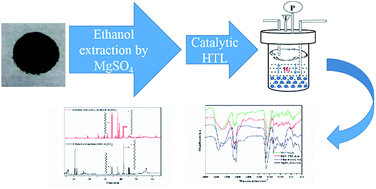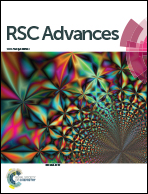Organic solvent extraction-assisted catalytic hydrothermal liquefaction of algae to bio-oil†
Abstract
In this paper, we report our investigation into a two-step method of transformation of algae to bio-oil. Elemental analysis, gas chromatography-mass spectrometry and Fourier transform infrared spectroscopy were used to analyze bio-oil. First, organic solvent Soxhlet extraction and reflux extraction were used in the algal extraction step. Ethanol was proven to be the best solvent, and the addition of MgSO4 could transform acids to esters. In MgSO4 extraction oil, the yield of hexadecanoic acid ethyl ester was as high as 48.40%. Then, the residual algae powders through the catalytic hydrothermal liquefaction process were converted to bio-oil. Commercialized noble metal catalysts Pd/C, Pt/C, Ru/C and Rh/C combined with Pd/HZSM-5 were used in the second step. Rh/C performed the best in the catalytic hydrothermal liquefaction process, and the highest bio-oil yield of 50.98% and HHV of 30.67 MJ kg−1 were achieved. The oil yield through two steps was higher than that by a direct decomposition step. Also, the two-step method could achieve a higher energy conversion ratio of 85.61% and total energy of 81.09 kJ.



 Please wait while we load your content...
Please wait while we load your content...